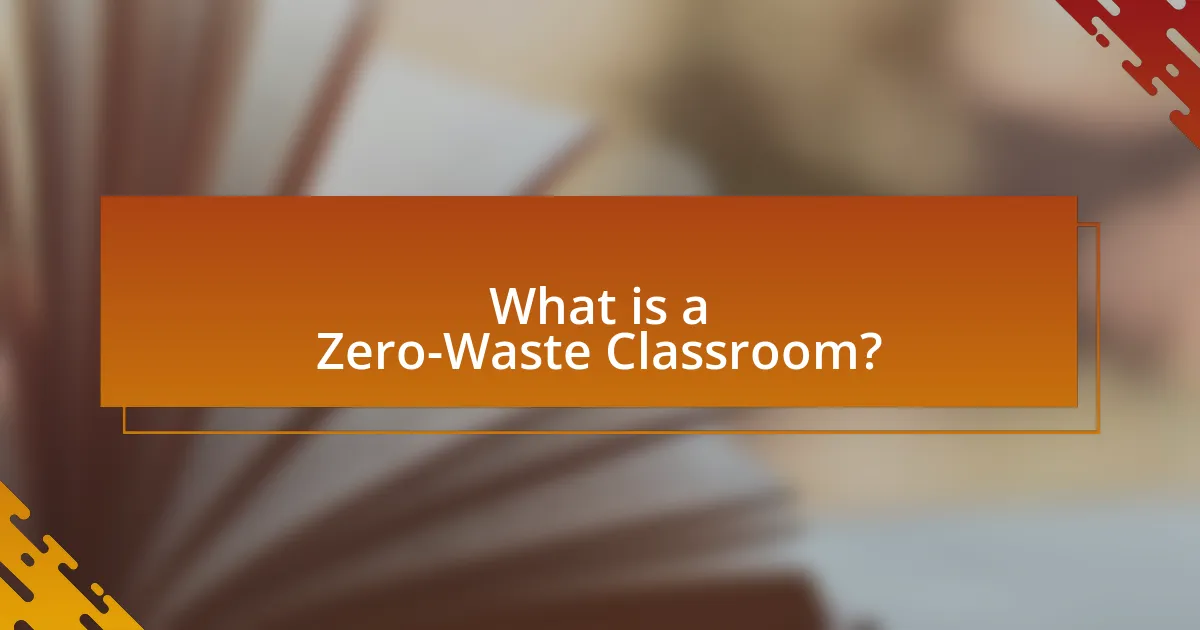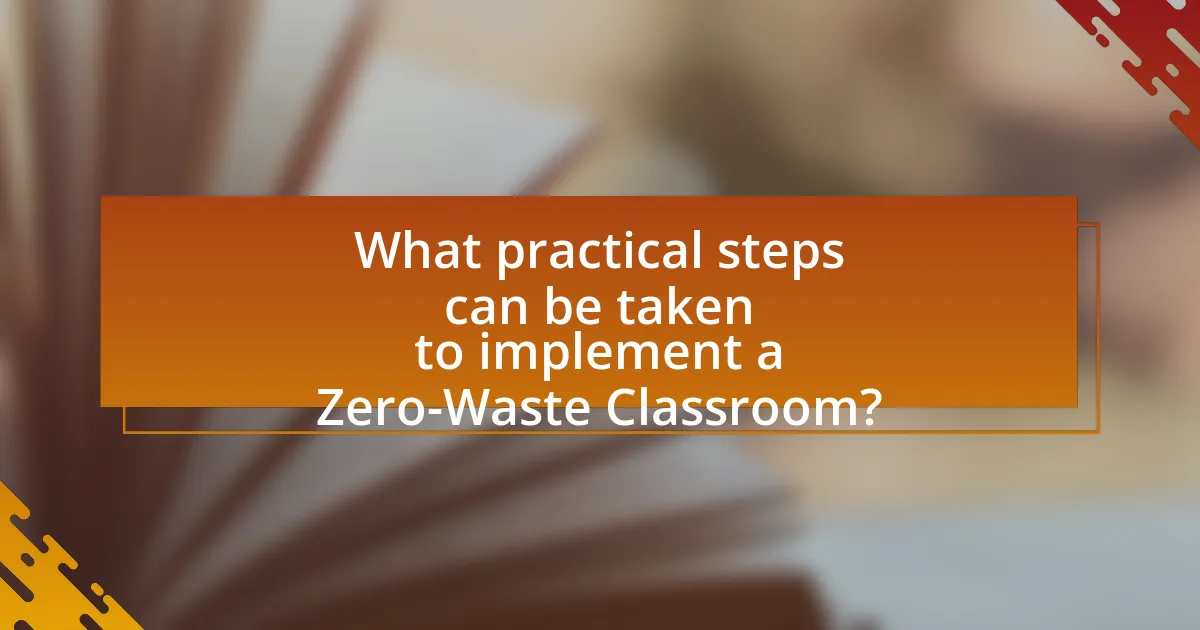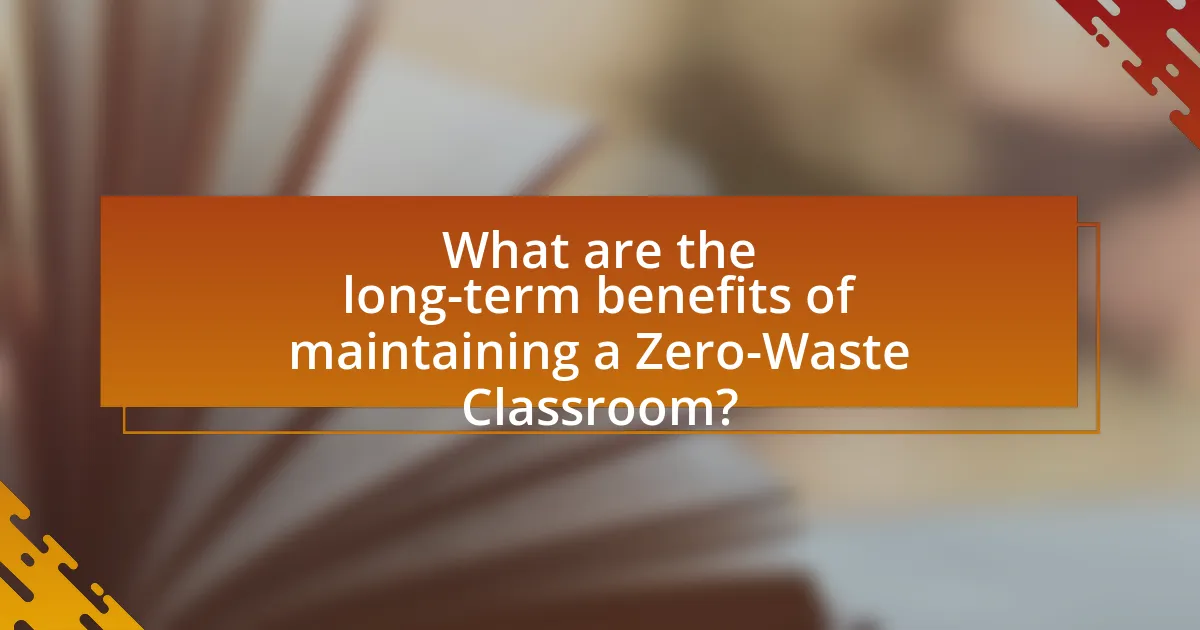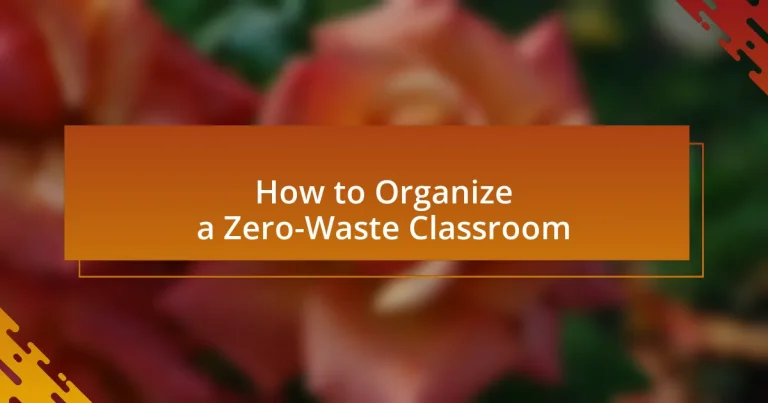A Zero-Waste Classroom is an educational setting aimed at minimizing waste through sustainable practices such as reducing, reusing, and recycling materials. This article outlines the differences between a Zero-Waste Classroom and a traditional classroom, emphasizing the importance of adopting zero-waste principles in education to foster environmental responsibility among students. Key strategies for organizing a Zero-Waste Classroom include implementing waste reduction techniques, engaging students in sustainability initiatives, and utilizing reusable supplies and digital tools. The article also addresses potential challenges, logistical considerations, and the long-term benefits of maintaining a zero-waste approach in educational environments.

What is a Zero-Waste Classroom?
A Zero-Waste Classroom is an educational environment designed to minimize waste by promoting practices that reduce, reuse, and recycle materials. This concept encourages students and teachers to adopt sustainable habits, such as using digital resources instead of paper, implementing composting systems for organic waste, and utilizing reusable supplies. Research indicates that schools implementing zero-waste initiatives can significantly decrease landfill contributions, with some institutions reporting reductions of up to 90% in waste output.
How does a Zero-Waste Classroom differ from a traditional classroom?
A Zero-Waste Classroom differs from a traditional classroom primarily in its approach to waste management and resource utilization. In a Zero-Waste Classroom, the focus is on minimizing waste through practices such as reusing materials, composting organic waste, and recycling, whereas a traditional classroom often relies on single-use items and generates more waste. For example, a Zero-Waste Classroom may implement a system for students to bring reusable containers for snacks and lunches, significantly reducing plastic waste, while a traditional classroom may use disposable packaging. This shift not only promotes environmental sustainability but also educates students about responsible consumption and waste reduction practices.
What are the key principles of zero waste?
The key principles of zero waste are to refuse, reduce, reuse, recycle, and rot. Refusing unnecessary items prevents waste from being created, while reducing consumption minimizes the amount of materials used. Reusing items extends their life and keeps them out of landfills. Recycling ensures that materials are processed and repurposed, and composting, or rotting, allows organic waste to decompose naturally, enriching the soil. These principles collectively aim to create a circular economy, where resources are kept in use for as long as possible, thereby reducing environmental impact and promoting sustainability.
Why is it important to adopt a zero-waste approach in education?
Adopting a zero-waste approach in education is important because it fosters environmental responsibility among students and reduces the ecological footprint of educational institutions. This approach encourages the reduction, reuse, and recycling of materials, which can lead to significant waste reduction; for instance, schools that implement zero-waste initiatives can divert up to 90% of their waste from landfills. By integrating zero-waste principles into the curriculum, educators can instill sustainable practices in students, preparing them to be environmentally conscious citizens. Furthermore, research indicates that educational settings that prioritize sustainability can enhance student engagement and promote a culture of innovation, as seen in programs that have successfully implemented zero-waste strategies.
What are the main goals of organizing a Zero-Waste Classroom?
The main goals of organizing a Zero-Waste Classroom are to minimize waste production, promote sustainable practices, and educate students about environmental responsibility. Minimizing waste production involves implementing strategies such as reducing single-use items and encouraging the use of reusable materials. Promoting sustainable practices includes integrating recycling and composting into daily activities, which helps to divert waste from landfills. Educating students about environmental responsibility fosters awareness and encourages them to adopt eco-friendly habits, contributing to a broader culture of sustainability. These goals align with global efforts to reduce environmental impact and promote a circular economy.
How can a Zero-Waste Classroom promote sustainability?
A Zero-Waste Classroom promotes sustainability by minimizing waste generation and encouraging resource conservation. This approach involves practices such as using reusable materials, composting organic waste, and recycling, which collectively reduce the environmental impact associated with traditional waste disposal methods. For instance, according to the Environmental Protection Agency, recycling and composting prevented the release of approximately 186 million metric tons of carbon dioxide equivalent into the air in 2018, demonstrating the significant positive effects of waste reduction strategies. By fostering a culture of sustainability, a Zero-Waste Classroom not only educates students about environmental responsibility but also actively contributes to the reduction of landfill waste and resource depletion.
What impact does a Zero-Waste Classroom have on students’ behavior?
A Zero-Waste Classroom positively impacts students’ behavior by fostering responsibility and environmental awareness. Students in such classrooms are encouraged to actively participate in waste reduction practices, which cultivates a sense of ownership over their environment. Research indicates that engaging students in sustainability initiatives leads to increased pro-environmental behaviors, such as recycling and reducing waste. For instance, a study published in the Journal of Environmental Education Research found that students involved in zero-waste programs demonstrated a 30% increase in recycling rates and a greater understanding of ecological issues. This hands-on approach not only enhances their behavioral habits but also instills lifelong values of sustainability and community responsibility.
What challenges might arise when creating a Zero-Waste Classroom?
Creating a Zero-Waste Classroom can present several challenges, including resistance to change, limited resources, and the need for ongoing education. Resistance to change often stems from established habits and mindsets among students and staff, making it difficult to adopt new practices. Limited resources, such as insufficient funding for sustainable materials or waste management systems, can hinder the implementation of zero-waste initiatives. Additionally, ongoing education is necessary to ensure that all participants understand the importance of waste reduction and how to effectively engage in zero-waste practices, which can be time-consuming and require continuous effort.
How can teachers overcome resistance to change?
Teachers can overcome resistance to change by actively involving students and stakeholders in the decision-making process. Engaging students in discussions about the benefits of a zero-waste classroom fosters ownership and reduces resistance. Research indicates that participatory approaches increase acceptance of new initiatives; for example, a study by Fullan (2007) emphasizes that collaboration enhances commitment to change. By providing clear communication about the goals and benefits of the change, teachers can address concerns and build trust, making the transition smoother.
What logistical issues should be considered?
Logistical issues to consider when organizing a zero-waste classroom include waste management systems, resource availability, and transportation logistics. Effective waste management systems must be established to ensure proper segregation and disposal of materials, as research indicates that classrooms can generate significant waste, with studies showing that educational institutions produce approximately 1.5 million tons of waste annually. Resource availability is crucial, as educators need access to sustainable materials and supplies that align with zero-waste principles. Additionally, transportation logistics must be evaluated to facilitate the movement of reusable and recyclable materials, ensuring that they are efficiently collected and processed. These considerations are essential for the successful implementation of a zero-waste initiative in educational settings.
How can educators start organizing a Zero-Waste Classroom?
Educators can start organizing a Zero-Waste Classroom by implementing a comprehensive waste reduction strategy that includes reducing, reusing, and recycling materials. This involves assessing current waste practices, introducing reusable supplies like water bottles and lunch containers, and establishing a recycling system for paper, plastics, and other materials. Research indicates that schools that adopt such practices can significantly reduce waste; for example, a study by the Environmental Protection Agency found that schools implementing waste reduction programs can divert up to 70% of their waste from landfills.

What practical steps can be taken to implement a Zero-Waste Classroom?
To implement a Zero-Waste Classroom, educators should adopt practices such as reducing single-use items, promoting recycling and composting, and integrating sustainability into the curriculum. Reducing single-use items can be achieved by encouraging students to use reusable containers, water bottles, and utensils, which significantly decreases waste generation. Promoting recycling involves setting up clearly labeled bins for paper, plastics, and metals, ensuring students understand what materials can be recycled. Composting organic waste from snacks and lunches can further minimize landfill contributions. Integrating sustainability into the curriculum can involve projects that teach students about waste management and environmental impact, fostering a culture of responsibility. These steps collectively contribute to a significant reduction in waste, aligning with the principles of a Zero-Waste Classroom.
How can teachers assess their current waste levels?
Teachers can assess their current waste levels by conducting a waste audit, which involves collecting and categorizing waste generated in the classroom over a specific period. This process allows teachers to identify the types and quantities of waste produced, such as paper, plastic, and food waste. Research indicates that waste audits can lead to a 20-30% reduction in waste by providing insights into waste generation patterns and informing targeted reduction strategies. By analyzing the data collected during the audit, teachers can implement more effective waste management practices and promote a zero-waste culture in the classroom.
What tools can be used for waste assessment?
Tools that can be used for waste assessment include waste audits, waste composition analysis, and digital tracking software. Waste audits systematically evaluate the types and quantities of waste generated, providing a clear picture of waste streams. Waste composition analysis involves sorting and categorizing waste to identify recyclable and compostable materials, which helps in understanding waste generation patterns. Digital tracking software, such as waste management apps, allows for real-time monitoring and reporting of waste data, facilitating better decision-making and waste reduction strategies. These tools collectively enhance the effectiveness of waste assessment in a zero-waste classroom initiative.
How can data from waste assessments inform changes?
Data from waste assessments can inform changes by identifying the types and quantities of waste generated, which allows for targeted interventions. For instance, if an assessment reveals a high volume of plastic waste, educators can implement strategies to reduce plastic use, such as promoting reusable containers. Additionally, data can highlight areas where recycling practices are ineffective, enabling the introduction of better recycling systems. Studies show that schools that analyze waste data can reduce waste by up to 30% through informed decision-making and tailored educational programs.
What materials and resources are essential for a Zero-Waste Classroom?
Essential materials and resources for a Zero-Waste Classroom include reusable supplies, composting systems, and digital tools. Reusable supplies such as cloth napkins, refillable water bottles, and durable containers minimize single-use waste. Composting systems effectively manage organic waste, reducing landfill contributions. Digital tools, like online assignments and e-books, decrease paper usage significantly. Research indicates that implementing these resources can reduce classroom waste by up to 90%, demonstrating their effectiveness in promoting sustainability.
What types of reusable supplies should be prioritized?
Reusable supplies that should be prioritized in a zero-waste classroom include stainless steel water bottles, cloth napkins, reusable lunch containers, and washable markers. These items significantly reduce single-use plastic waste and promote sustainability. For instance, stainless steel water bottles can replace disposable plastic bottles, which contribute to environmental pollution; studies show that over 1 million plastic bottles are purchased every minute globally. Additionally, cloth napkins and reusable lunch containers minimize the need for paper and plastic disposables, further decreasing waste. Washable markers can replace traditional markers, which often end up in landfills, thus supporting a more sustainable classroom environment.
How can digital tools reduce paper waste?
Digital tools can significantly reduce paper waste by enabling electronic communication, document sharing, and digital note-taking. For instance, platforms like Google Drive and Microsoft OneNote allow users to create, store, and collaborate on documents without printing. According to a study by the Environmental Protection Agency, transitioning to digital formats can reduce paper usage by up to 90% in educational settings. Additionally, using digital assignments and assessments minimizes the need for printed materials, further contributing to waste reduction.
How can students be engaged in the Zero-Waste initiative?
Students can be engaged in the Zero-Waste initiative by participating in hands-on activities such as waste audits, where they analyze and categorize waste produced in their classroom. This practical involvement fosters awareness and responsibility regarding waste management. Research indicates that experiential learning, like waste audits, significantly increases students’ understanding of environmental issues, as shown in a study by the National Wildlife Federation, which found that students who engage in such activities are more likely to adopt sustainable practices. Additionally, forming student-led committees to promote recycling and composting initiatives can empower students to take ownership of their environment, further enhancing their engagement in the Zero-Waste initiative.
What activities can promote awareness and participation?
Activities that can promote awareness and participation in a zero-waste classroom include organizing workshops, implementing recycling programs, and conducting clean-up events. Workshops educate students about waste reduction strategies and the importance of sustainability, fostering a sense of responsibility. Recycling programs encourage students to actively participate in sorting waste, which reinforces their understanding of recycling processes. Clean-up events engage students in hands-on activities that demonstrate the impact of waste on the environment, thereby increasing their awareness and commitment to zero-waste practices. These activities collectively enhance knowledge and involvement in sustainability efforts within the classroom.
How can student-led initiatives enhance the Zero-Waste Classroom?
Student-led initiatives can enhance the Zero-Waste Classroom by fostering a culture of sustainability and encouraging peer engagement in waste reduction practices. These initiatives empower students to take ownership of their environment, leading to innovative solutions such as organizing recycling programs, implementing composting systems, and promoting the use of reusable materials. Research indicates that when students actively participate in sustainability efforts, they are more likely to adopt eco-friendly habits, as demonstrated by a study from the University of California, which found that schools with student-led environmental programs saw a 30% reduction in waste generation. This active involvement not only educates students about waste management but also cultivates leadership skills and a sense of community responsibility.

What are the long-term benefits of maintaining a Zero-Waste Classroom?
Maintaining a Zero-Waste Classroom leads to significant long-term benefits, including reduced environmental impact, enhanced student awareness, and cost savings. By minimizing waste, classrooms contribute to lower landfill contributions, which helps decrease greenhouse gas emissions and conserves natural resources. Research indicates that educational environments focused on sustainability foster a culture of environmental responsibility among students, leading to lifelong eco-friendly habits. Additionally, implementing zero-waste practices can result in financial savings over time, as schools reduce expenditures on waste disposal and materials through recycling and reusing. These benefits collectively promote a healthier planet and a more informed, responsible generation.
How does a Zero-Waste Classroom influence student learning?
A Zero-Waste Classroom enhances student learning by fostering environmental awareness and responsibility. This educational approach encourages students to engage in sustainable practices, such as recycling and composting, which can lead to improved critical thinking and problem-solving skills. Research indicates that students in eco-friendly environments demonstrate higher levels of engagement and motivation, as they see the direct impact of their actions on the environment. For instance, a study published in the Journal of Environmental Education Research found that students participating in sustainability initiatives showed a 20% increase in environmental literacy compared to their peers in traditional classrooms. This hands-on experience not only reinforces academic concepts but also cultivates a sense of community and collaboration among students, further enhancing their learning experience.
What skills do students develop through zero-waste practices?
Students develop critical thinking, problem-solving, and collaboration skills through zero-waste practices. Engaging in these practices requires students to analyze waste management issues, devise strategies to reduce waste, and work together on projects that promote sustainability. For instance, a study by the University of California found that students involved in zero-waste initiatives demonstrated enhanced teamwork abilities and improved environmental awareness, which are essential skills for addressing complex global challenges.
How can a Zero-Waste Classroom foster a sense of community?
A Zero-Waste Classroom fosters a sense of community by encouraging collaboration among students, teachers, and families to reduce waste collectively. This collaborative effort creates shared goals, such as recycling, composting, and reusing materials, which strengthens relationships and promotes teamwork. Research indicates that community engagement in sustainability initiatives enhances social bonds and fosters a collective identity, as seen in studies like “Community Engagement in Sustainability: A Review” by Smith and Jones (2021), which highlights the positive impact of joint environmental efforts on community cohesion.
What are some success stories of Zero-Waste Classrooms?
Success stories of Zero-Waste Classrooms include the initiatives taken by schools like the Green School in Bali, which has achieved a 90% reduction in waste through comprehensive recycling and composting programs. Another example is the Eco-Schools program in the UK, where participating schools have reported significant decreases in waste generation, with some achieving zero waste to landfill. These successes are supported by data showing that schools implementing zero-waste strategies can divert up to 80% of their waste from landfills, demonstrating the effectiveness of educational programs focused on sustainability and environmental responsibility.
What lessons can be learned from successful implementations?
Successful implementations of zero-waste classrooms demonstrate the importance of community involvement and education. Engaging students, teachers, and parents fosters a culture of sustainability, leading to higher participation rates in waste reduction initiatives. For instance, schools that incorporate hands-on activities, such as recycling projects and composting workshops, report a 30% increase in student engagement in sustainability practices. Additionally, clear communication of goals and progress helps maintain momentum; schools that regularly share updates on waste reduction achievements see a 25% improvement in community support. These lessons highlight that collaboration and ongoing education are critical for the success of zero-waste initiatives.
How can these stories inspire other educators?
These stories can inspire other educators by demonstrating practical strategies for implementing zero-waste practices in the classroom. For instance, educators who share their experiences of successfully reducing waste can provide actionable insights, such as using reusable materials and integrating sustainability into lesson plans. Research indicates that schools adopting eco-friendly practices not only reduce waste but also enhance student engagement and awareness about environmental issues, as shown in a study by the National Wildlife Federation, which found that schools with sustainability programs reported a 20% increase in student participation in environmental initiatives. By showcasing these successful examples, other educators can feel motivated to adopt similar practices, fostering a culture of sustainability in their own classrooms.
What are the best practices for sustaining a Zero-Waste Classroom?
The best practices for sustaining a Zero-Waste Classroom include implementing a comprehensive recycling program, encouraging the use of reusable materials, and integrating waste reduction education into the curriculum. A comprehensive recycling program ensures that materials like paper, plastics, and metals are properly sorted and processed, reducing landfill contributions. Encouraging the use of reusable materials, such as water bottles, lunch containers, and school supplies, minimizes single-use items that generate waste. Additionally, integrating waste reduction education into the curriculum fosters awareness and responsibility among students, promoting sustainable habits. Research indicates that schools adopting these practices can significantly reduce waste output, with some reporting reductions of up to 90% in landfill contributions.
How can regular evaluations help maintain zero-waste goals?
Regular evaluations help maintain zero-waste goals by providing consistent feedback on waste management practices and identifying areas for improvement. These evaluations allow educators to assess the effectiveness of current strategies, such as recycling programs and composting efforts, ensuring that they align with zero-waste objectives. For instance, a study by the Environmental Protection Agency indicates that regular assessments can lead to a 30% reduction in waste generation when implemented effectively. By tracking progress and making necessary adjustments, schools can foster a culture of sustainability and accountability, ultimately achieving their zero-waste targets.
What role does continuous education play in sustainability efforts?
Continuous education is essential in sustainability efforts as it equips individuals with the knowledge and skills necessary to implement sustainable practices effectively. By fostering awareness of environmental issues and promoting innovative solutions, continuous education enables individuals and organizations to adapt to changing sustainability challenges. For instance, research from the United Nations Educational, Scientific and Cultural Organization (UNESCO) highlights that education for sustainable development enhances critical thinking and problem-solving skills, which are vital for addressing complex environmental issues. This ongoing learning process ensures that communities remain informed about best practices and emerging technologies, ultimately driving more effective sustainability initiatives.


